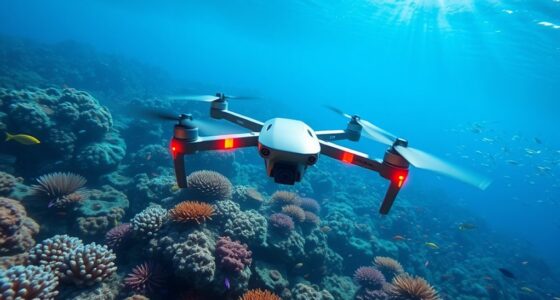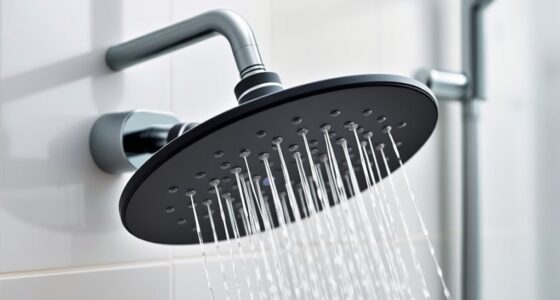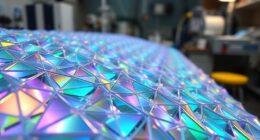If you’re exploring the top Jetson Nano robotics kits for 2025, I’ve found options that suit all skill levels, from powerful edge AI platforms like Seeed Studio’s J1010 Kit and Orin Nano Super Developer Kit to beginner-friendly kits like JetBot and Yahboom’s robotic kits with cameras, lidar, and autonomous features. These setups support AI, navigation, and automation, perfect for innovators. Keep going, and you’ll discover detailed insights on each kit and how to choose the best one for your projects.
Key Takeaways
- The list includes high-performance AI devices like NVIDIA Jetson Orin Nano and AGX Orin for advanced robotics projects.
- It features beginner-friendly kits such as JetBot and Yahboom robotics sets suitable for educational use.
- Many kits offer robust connectivity options, sensors, and AI capabilities for real-time autonomous navigation.
- The selection covers various skill levels, from hobbyists and students to professional developers.
- Durability, ease of assembly, and comprehensive software support are key factors in the top kits listed.
Seeed Studio NVIDIA Jetson Nano Edge AI Device (J1010 Kit)
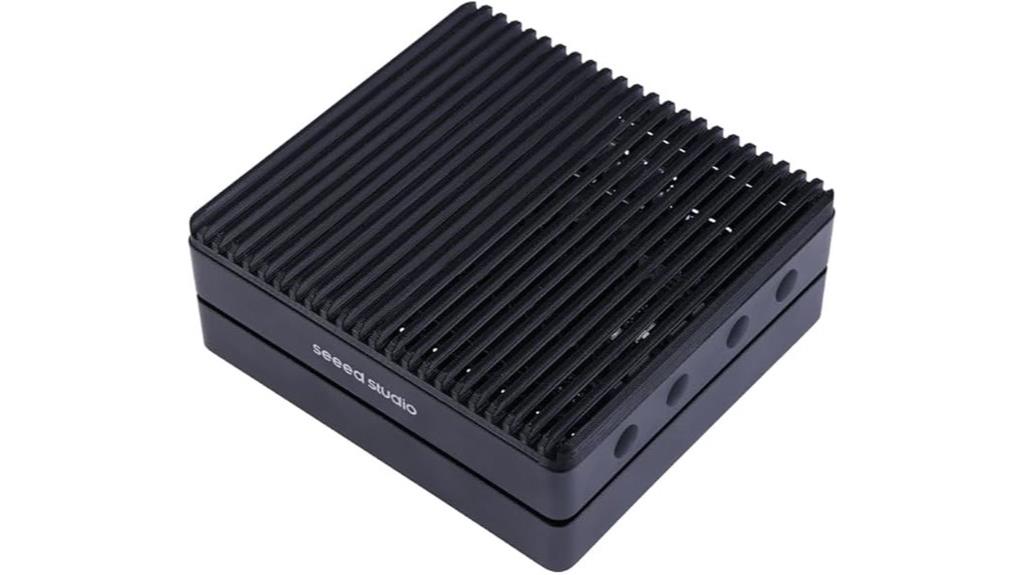
If you’re looking for a compact, durable AI solution for edge computing projects, the Seeed Studio NVIDIA Jetson Nano Edge AI Device (J1010 Kit) is an excellent choice. Its mini PC design resembles the Jetson Nano Developer Kit but offers rich I/O options like Gigabit Ethernet, USB 3.0 & 2.0, and HDMI ports. The aluminium case guarantees durability and effective thermal management. Pre-installed with NVIDIA JetPack software, it’s ready for cloud-native applications and supports industry-leading AI frameworks. With 0.5 TFLOPs of processing power and fast inference speeds, it’s perfect for autonomous machines, industrial environments, and smart city projects, making it an ideal edge AI device.
Best For: embedded AI developers and industrial automation projects seeking a durable, compact edge computing device with robust I/O and high-performance AI inference capabilities.
Pros:
- Rich set of I/O ports including Gigabit Ethernet, USB 3.0 & 2.0, and HDMI for versatile connectivity
- Durable aluminium case with effective thermal management for outdoor and industrial environments
- Pre-installed NVIDIA JetPack software supporting industry-leading AI frameworks and rapid deployment
Cons:
- Power supply and RTC battery are sold separately, adding to initial setup costs
- Limited processing power with 0.5 TFLOPs may not suffice for highly complex AI models
- No included storage or peripherals, requiring additional accessories for complete setup
seeed studio NVIDIA Jetson Orin Nano Super Developer Kit
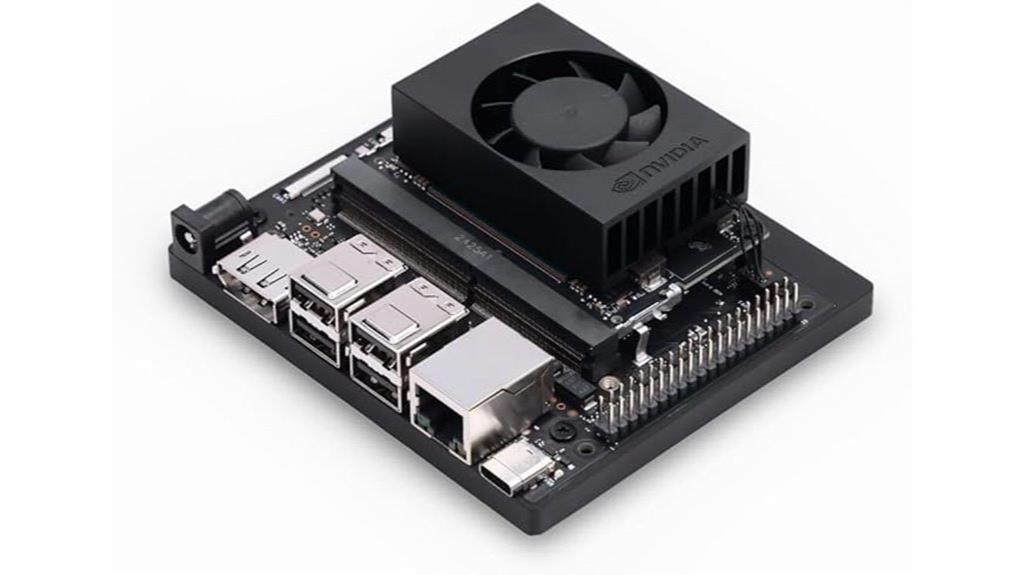
The seeed studio NVIDIA Jetson Orin Nano Super Developer Kit stands out as the ideal choice for advanced robotics enthusiasts and developers seeking high-performance edge AI solutions. With its Jetson Orin Nano 8GB module, it delivers up to 67 TOPS AI performance, offering a significant boost over previous models. Its compact size (100mm x 79mm x 21mm) makes it perfect for production environments where space is limited. The kit includes extensive I/O options—USB, HDMI, Wi-Fi, SSD slots, GPIO, and more—enabling seamless connectivity. Although firmware needs updating, it supports multiple AI pipelines for low-latency, high-inference tasks, making it a versatile powerhouse.
Best For: advanced robotics developers and AI enthusiasts seeking a compact, high-performance edge AI solution for production environments.
Pros:
- Delivers up to 67 TOPS AI performance, significantly boosting inference capabilities
- Compact size (100mm x 79mm x 21mm) ideal for space-constrained applications
- Rich I/O options including USB, HDMI, Wi-Fi, SSD slots, and GPIO for versatile connectivity
Cons:
- Firmware requires updating before use, which may be an extra step for users
- Outdated factory-flashed firmware incompatible with JetPack 6.x versions
- Slightly higher price point compared to less powerful SBC alternatives
NVIDIA Jetson Orin Nano Super Developer Kit
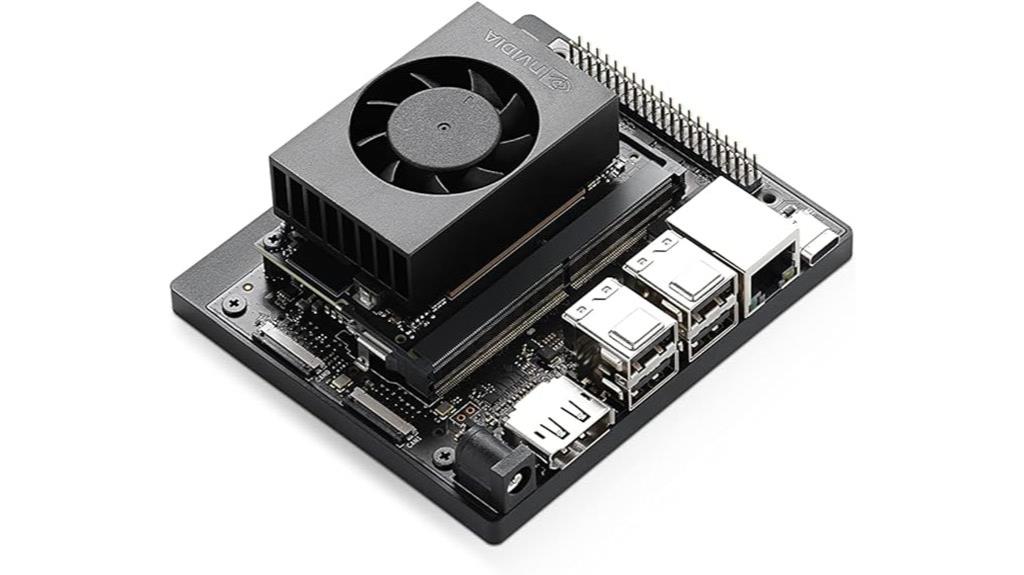
The NVIDIA Jetson Orin Nano Super Developer Kit stands out for its impressive AI performance, delivering up to 67 TOPS, which is a 1.7X boost over earlier models. This compact yet powerful edge AI computer supports vision transformers, large language models, and generative AI applications. It features a Jetson Orin Nano 8GB module with an Ampere GPU and a 6-core ARM CPU, enabling high-performance inference and multiple AI pipelines simultaneously. The versatile carrier board offers extensive connectivity, including MIPI CSI connectors for high-resolution camera modules. With NVIDIA’s robust software ecosystem, it’s ideal for robotics, autonomous machines, and rapid prototyping.
Best For: developers and engineers seeking a high-performance, compact edge AI platform for robotics, vision, and generative AI applications.
Pros:
- Delivers up to 67 TOPS of AI performance, a significant boost over previous models.
- Supports advanced AI workloads including vision transformers, large language models, and generative AI.
- Features versatile connectivity options with MIPI CSI connectors for high-resolution camera integration.
Cons:
- May require advanced technical knowledge for setup and optimization.
- Limited to 8GB RAM, which might restrict extremely large AI models or datasets.
- Higher cost compared to less powerful or less feature-rich edge AI solutions.
Yahboom AI Robotic Kit with Jetson Nano for Teens and Adults

For teens and adults enthusiastic to explore advanced robotics, the Yahboom AI Robotic Kit with Jetson Nano stands out thanks to its robust autonomous navigation and versatile control options. It features a sturdy aluminum alloy frame, SLAM lidar, robotic arm, and a 7-inch touch screen, with optional depth cameras for enhanced vision. The kit supports Bluetooth, multiple control methods—including mobile apps, handle, and ROS—and offers extensive tutorials and open-source code for customization. Its AI capabilities include face detection, object tracking, obstacle avoidance, and 3D mapping with Astra Pro. Overall, it’s a durable, flexible platform perfect for learning and developing complex robotics projects.
Best For: robotics enthusiasts, educators, and developers seeking a durable, customizable platform for advanced autonomous navigation and AI projects.
Pros:
- Robust construction with high-quality aluminum alloy frame and durable components
- Extensive educational resources, tutorials, and open-source code for easy customization
- Advanced AI features including face detection, object tracking, and 3D mapping with Astra Pro
Cons:
- Assembly process can take around 6 hours and may be complex for beginners
- Some manuals are only available in Mandarin, posing language barriers for non-Chinese speakers
- Initial hardware issues such as wiring complexity and occasional faults like I2C problems with robotic arm
JetBot AI Kit for Jetson Nano — Smart AI Robot with Camera, ROS, WiFi, Bluetooth, Facial Recognition, and Object Tracking

If you’re looking to plunge into AI robotics with a versatile and beginner-friendly kit, the JetBot AI Kit for Jetson Nano is an excellent choice. It comes with a powerful Jetson Nano module, an 8MP camera with a 160° FOV, and dual-mode WiFi and Bluetooth for seamless connectivity. The kit features facial recognition, object tracking, auto line following, and collision avoidance, making it perfect for developing intelligent robots. With ROS integration and open-source code, it simplifies learning robotics programming and system design. Whether you’re a hobbyist or an educator, this kit provides the tools to create and experiment with smart AI robots easily.
Best For: hobbyists, educators, and beginners interested in AI robotics, system integration, and robotics programming using a versatile and beginner-friendly kit.
Pros:
- Comes with a powerful Jetson Nano module and high-quality 8MP camera with wide 160° FOV for detailed vision tasks
- Supports seamless connectivity with dual-mode WiFi and Bluetooth, enabling real-time communication and data transfer
- Features ROS integration and open-source code, simplifying learning and development of intelligent robotic systems
Cons:
- May require some prior knowledge of robotics or programming to maximize its capabilities
- Limited to beginner and educational projects; may not suit advanced or industrial robotics needs
- Physical setup and assembly might be challenging for complete novices without additional guidance
Yahboom Jetson Nano Robot Kit for AI Robotic Car Tank Chassis
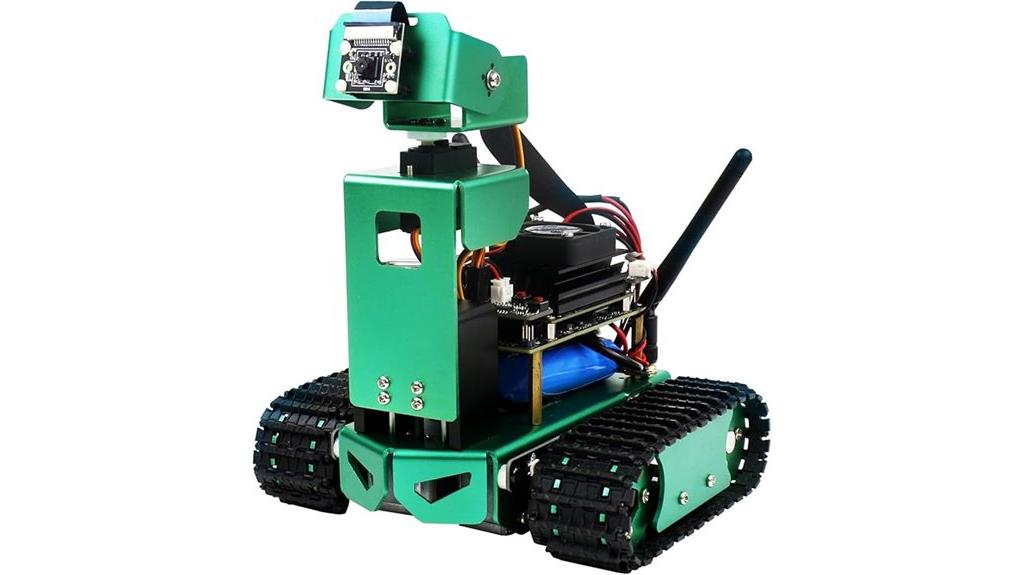
Designed for robotics enthusiasts and learners over 18, the Yahboom Jetson Nano Robot Kit stands out with its rugged tank-style chassis and advanced AI capabilities. Built from durable matte aluminum, it offers stability and a sturdy platform for projects. Equipped with a 3DOF HD camera and programmable electronics, it supports autonomous functions like autopilot, object tracking, face recognition, and obstacle avoidance. Control options include Python and a Wi-Fi-connected Android app. While assembly is straightforward, some users face minor issues like tight connectors and fragile parts. Overall, it’s a versatile kit perfect for exploring AI robotics, combining durability with impressive features for educational and hobbyist use.
Best For: robotics enthusiasts, students, and hobbyists over 18 interested in AI-driven DIY robotic projects and autonomous vehicle development.
Pros:
- Durable matte aluminum chassis ensures stability and long-term use.
- Supports advanced AI functions like face recognition, object tracking, and autopilot with open-source software.
- Easy-to-follow assembly instructions and versatile control options via Python and Wi-Fi app.
Cons:
- Some assembly issues such as tight connectors and fragile parts may require careful handling.
- Limited sensors for obstacle avoidance, relying heavily on software-based AI features.
- Software documentation can be confusing, and initial setup might involve troubleshooting Wi-Fi connectivity.
Seeed Studio NVIDIA Jetson Orin NX 16GB Edge AI Device
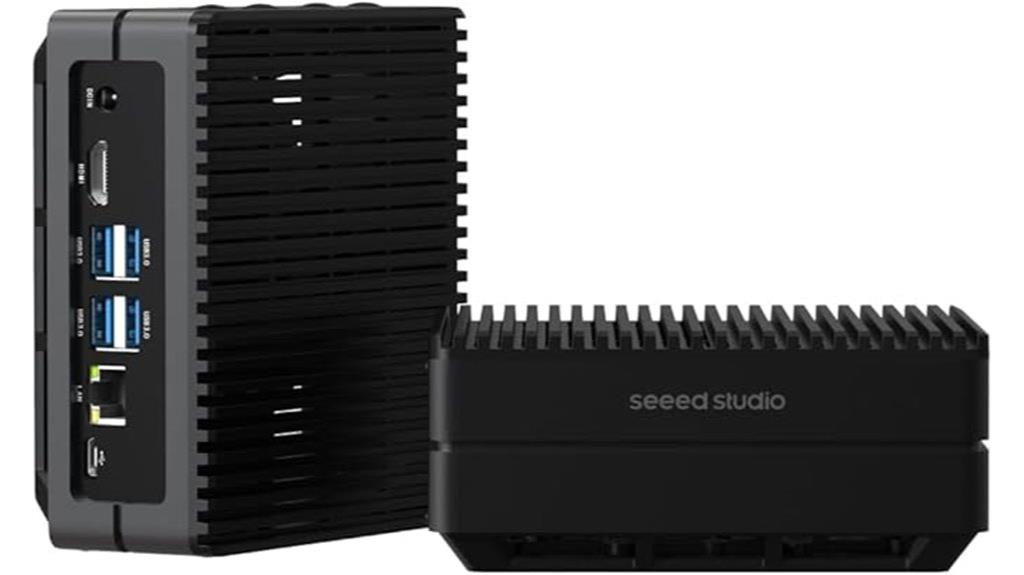
The Seeed Studio NVIDIA Jetson Orin NX 16GB Edge AI Device stands out with its impressive 100 TOPS AI performance, making it ideal for advanced edge AI projects. It offers low power consumption and low latency, perfect for real-time processing. The compact design (130mm x 120mm x 58.5mm) includes a cooling fan, heatsink, enclosure, and power adapter, enabling versatile deployment on desktops or walls. With rich I/O options like USB, HDMI, CSI, Ethernet, and M.2 slots, it supports easy integration. Pre-installed with Jetpack 5.1 and a 128GB NVMe SSD, it accelerates deployment for demanding AI applications.
Best For: edge AI developers and engineers seeking a compact, high-performance AI computing device for real-time applications and deployment in diverse environments.
Pros:
- Delivers up to 100 TOPS AI performance with low power consumption and low latency
- Compact size with versatile mounting options for various deployment environments
- Rich I/O connectivity supporting a wide range of peripherals and sensors
Cons:
- Power adapter sold separately, adding to total cost and setup considerations
- Requires familiarity with NVIDIA JetPack and Linux-based AI frameworks for optimal use
- Limited to 16GB RAM, which may not suffice for extremely large AI models or datasets
Jetson Nano B01 4GB Development Kit for AI and Robotics
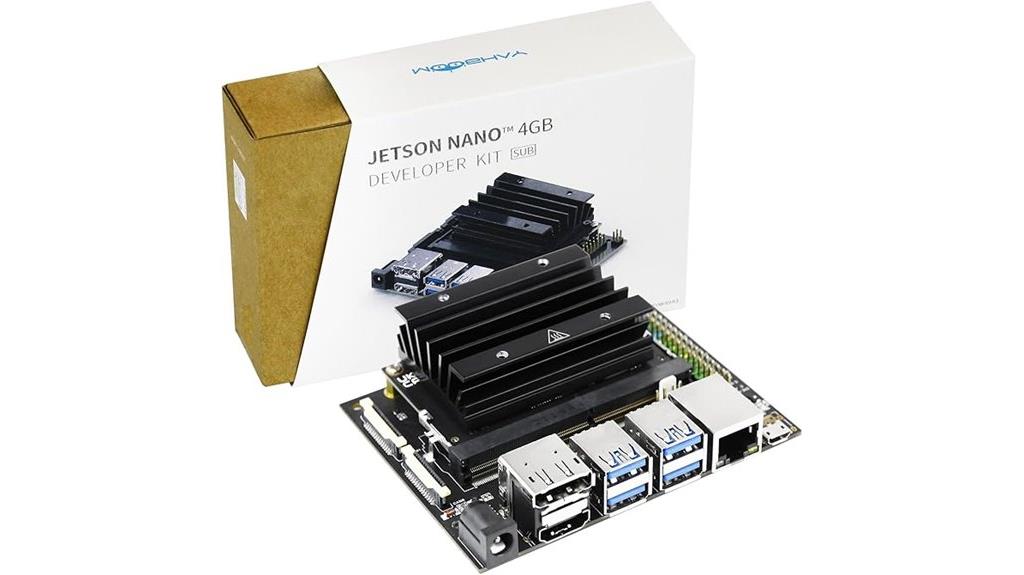
The Jetson Nano B01 4GB Development Kit stands out as an ideal choice for beginners and hobbyists delving into AI and robotics, thanks to its powerful NVIDIA Tegra processor and extensive I/O support. With a 1.5GHz processor, 4GB RAM, and Linux OS, it handles image classification, object detection, and speech processing effectively. Its GPIO and CSI interfaces allow easy sensor connections, making it versatile for various projects. Supported by the NVIDIA JetPack SDK, it simplifies development with tools like CUDA and TensorRT. Despite some user frustrations with performance and support, it remains a solid, compact platform for learning and prototyping AI-driven robotics.
Best For: beginners and hobbyists interested in AI, robotics, and computer vision projects who want a compact, affordable development platform.
Pros:
- Supports extensive I/O interfaces like GPIO and CSI for versatile sensor connections
- Compatible with NVIDIA JetPack SDK, including CUDA, cuDNN, and TensorRT, simplifying development
- Compact and energy-efficient design suitable for embedded applications
Cons:
- User reports of lagging, overheating, and inconsistent performance under moderate workloads
- Incomplete or difficult-to-follow documentation can delay setup and development
- Customer support issues and reports of devices bricking can hinder troubleshooting and long-term use
NVIDIA Jetson AGX Orin 64GB Developer Kit

If you’re aiming to develop cutting-edge AI-powered robots or autonomous systems, the NVIDIA Jetson AGX Orin 64GB Developer Kit stands out as an ideal choice. It offers up to 275 TOPS AI performance in a compact design with extensive connectors, supporting multiple high-speed AI pipelines. Powered by NVIDIA’s Ampere architecture, it handles complex models for vision, natural language, and sensor fusion. The kit runs NVIDIA’s versatile AI software stack, including Isaac, DeepStream, and Riva, making development streamlined. With hardware that emulates all Jetson Orin modules and support from NVIDIA’s ecosystem, it’s perfect for prototyping advanced AI robots and autonomous machines.
Best For: AI developers and engineers designing advanced robotics, autonomous systems, and complex AI applications requiring high performance and versatility.
Pros:
- Up to 275 TOPS AI performance enabling handling of sophisticated models.
- Compact design with extensive high-speed connectors for flexible integration.
- Supports multiple concurrent AI pipelines and a broad software ecosystem for streamlined development.
Cons:
- May require significant technical expertise to fully utilize all features.
- Higher cost compared to less powerful or simpler development kits.
- Power consumption and thermal management might necessitate additional cooling solutions for extended use.
Jetson Nano Developer Kit with 16GB eMMC for AI and Machine Learning

For aspiring innovators focused on AI and machine learning projects, the Jetson Nano Developer Kit with 16GB eMMC stands out due to its onboard storage and streamlined setup. It’s based on the official Jetson Nano 4GB core module but offers 16GB of eMMC storage, allowing for booting without a TF card. Equipped with a 143 GHz processor, 4GB RAM, and support for Linux Ubuntu 18.04, it’s ideal for tasks like image classification and speech processing. The kit includes a cooling fan, reference carrier board, and USB 3.0 expansion. While powerful and versatile, it’s somewhat outdated and may face software upgrade limitations, making it best suited for specific projects rather than long-term deployments.
Best For: enthusiasts, developers, and learners seeking a compact, cost-effective AI and machine learning platform with onboard storage for prototyping and educational purposes.
Pros:
- Easy to set up with Linux Ubuntu 18.04 and support for JetPack SDK, enabling quick deployment of AI applications.
- Onboard 16GB eMMC provides ample storage, allowing for board boot without a TF card.
- Compact size and integrated cooling fan make it suitable for embedded AI projects and space-constrained environments.
Cons:
- Limited upgrade support and potential boot issues when updating to newer JetPack versions.
- Outdated hardware and software support, making it less suitable for long-term or cutting-edge projects.
- Mixed reviews regarding usability and documentation, which may pose challenges for beginners.
Jetson Orin Nano 8GB RAM Development Board Kit
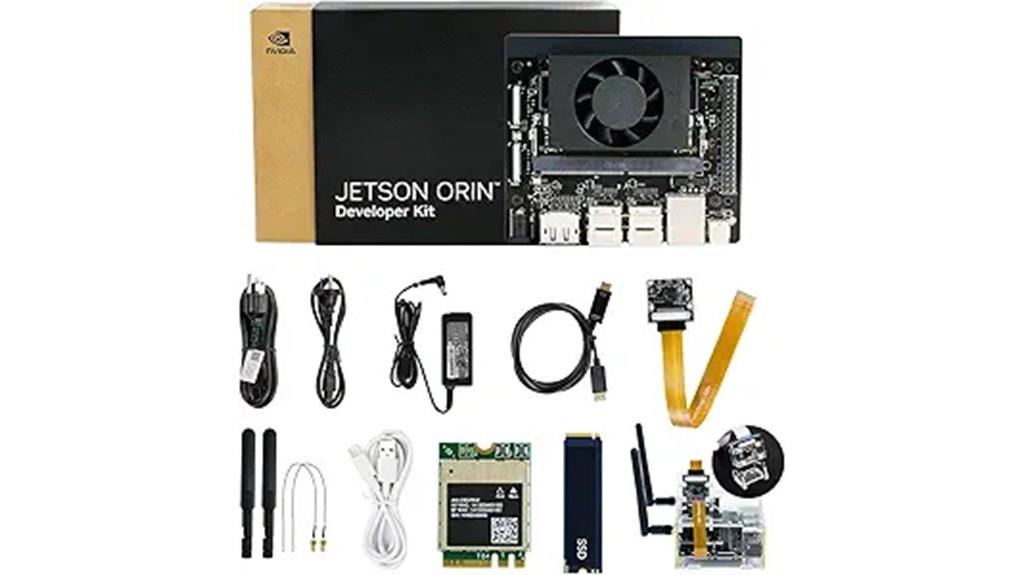
With its impressive 67 TOPS AI performance and robust hardware design, the Jetson Orin Nano 8GB RAM Development Board Kit stands out as an ideal choice for aspiring roboticists aiming to push the boundaries of AI-powered projects. It features a 1024-core NVIDIA Ampere GPU, 32 Tensor Cores, and a 6-core Arm Cortex-A78AE CPU, supported by 4GB or 8GB LPDDR5 memory. The kit offers stable power options, active heat dissipation, and reliable connectivity with Ethernet and Wi-Fi. Compatible with Ubuntu, ROS, and AI vision tools, it’s perfect for robotics, drone data processing, and more. Its extensive package includes the board, accessories, and excellent support from Yahboom.
Best For: robotics enthusiasts, AI developers, and researchers seeking a high-performance, versatile development platform for advanced AI and robotics projects.
Pros:
- Exceptional 67 TOPS AI performance with a powerful NVIDIA Ampere GPU and Tensor Cores
- Robust connectivity options including Ethernet, Wi-Fi, and POE support for versatile network integration
- Supports multiple power modes and active heat dissipation for stable and efficient operation
Cons:
- Larger physical size may require ample workspace and suitable mounting options
- Higher price point compared to entry-level single board computers
- Requires familiarity with Linux, AI frameworks, and system flashing for optimal setup
5-in-1 STEM Robot Building Kit (560 PCS, APP/Remote Control, Coding Robots)

The 5-in-1 STEM Robot Building Kit stands out as an excellent choice for young robotics enthusiasts aged 8-12 who want to combine hands-on building with coding and remote control play. With 560 pieces, it allows kids to build five different models, including robots, tanks, and bulldozers, promoting creativity and engineering skills. The kit features realistic functions like moving arms, turrets, and adjustable heads, all controllable via a Bluetooth app or remote. Designed from durable, safe plastic, it encourages problem-solving through easy-to-follow instructions. Perfect for fostering STEM learning, it offers hours of active, screen-free fun for kids and teens.
Best For: young robotics enthusiasts aged 8-12 who enjoy hands-on building, coding, and remote-controlled play to develop STEM skills.
Pros:
- Includes 560 pieces for building multiple models, encouraging creativity and engineering skills
- Features realistic functions like moving arms, turrets, and adjustable heads controllable via Bluetooth app or remote
- Made from durable, safe plastic with easy-to-follow instructions, suitable for children aged 6 and up
Cons:
- Small, varied-sized parts may pose challenges for younger children and require careful handling
- Some users report minor issues with misplaced pieces or loose parts after assembly
- Instruction images can be small and may be difficult for younger users to follow precisely
Yahboom Hexapod Robot for Raspberry Pi and Jetson Nano

Designed for serious hobbyists and educators, the Yahboom Hexapod Robot seamlessly integrates with Raspberry Pi or Jetson Nano, making it an excellent choice for hands-on AI and robotics projects. This adult robotic kit features six legs with 18 bionic joints powered by high-torque servo motors, enabling smooth, precise movement on various terrains. Its durable aluminum alloy body guarantees longevity and outdoor capability. Equipped with AI vision for face, gesture, and QR code recognition, it supports deep learning with OpenCV and Python. The robot’s 1080p camera and wireless remote control provide immersive, obstacle-free operation, perfect for STEM education and entertainment.
Best For: hobbyists, educators, and students interested in hands-on AI and robotics projects using Raspberry Pi or Jetson Nano.
Pros:
- High-precision movement with 6 legs and 18 bionic joints powered by high-torque servo motors
- Durable aluminum alloy body suitable for outdoor and high-intensity use
- Advanced AI vision capabilities including face, gesture, and QR code recognition with support for deep learning via OpenCV and Python
Cons:
- Requires a compatible Raspberry Pi 4B or Jetson Nano for operation, adding to the overall cost
- Does not include the development board, which must be purchased separately
- Suitable for ages 18+ due to complexity and mechanical components
Yahboom Jetson Orin Nano Robot Kit with 4GB RAM and ROS2 for Mapping and Navigation
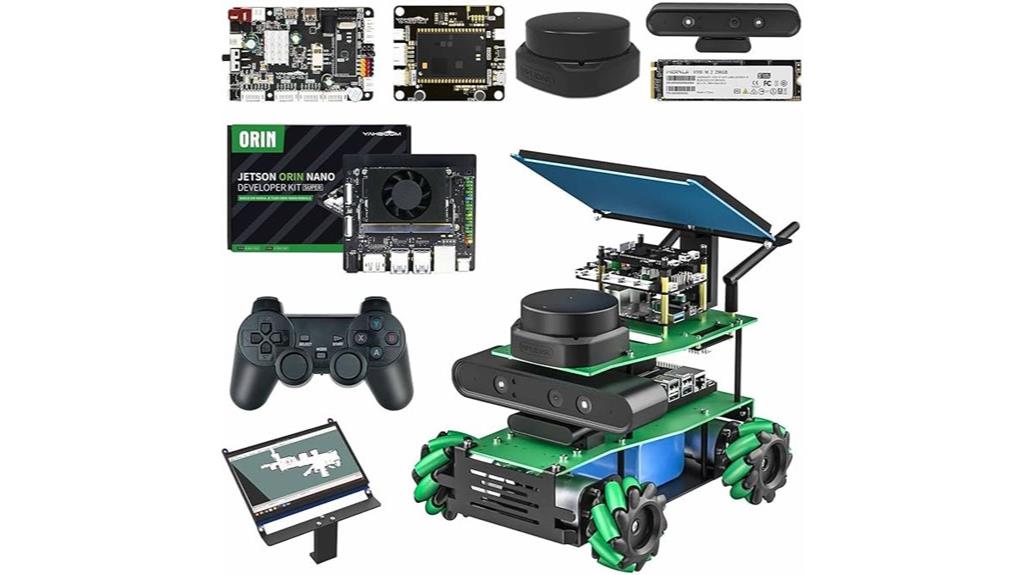
If you’re looking for a robotics kit that combines powerful processing with advanced navigation capabilities, the Yahboom Jetson Orin Nano Robot Kit with 4GB RAM and ROS2 stands out as an excellent choice. It features a sturdy, metal-like frame, mecanum wheels for versatile movement, lidar for precise mapping, and real-time object detection. The robot supports autonomous operation, voice commands, and control via phone app or joystick. Designed for indoor and outdoor use, it offers extended battery life and customizable RGB lighting. Perfect for learning robotics, programming, and navigation, this kit provides a challenging yet rewarding experience for hobbyists and students alike.
Best For: hobbyists, students, and robotics enthusiasts seeking a high-performance, programmable robot kit with advanced navigation and mapping capabilities.
Pros:
- Supports autonomous operation with lidar-based mapping and obstacle avoidance
- Compatible with multiple control modes including phone app, joystick, and autopilot
- Built with durable, metal-like frame and high-capacity battery for extended outdoor use
Cons:
- Higher price point may be a barrier for some users
- App support issues, particularly with MakerControl, limit remote control options
- Some connectivity and software compatibility challenges can require troubleshooting
Jetson Nano Kit with SD Slot, 16GB EMMC for AI and Machine Learning
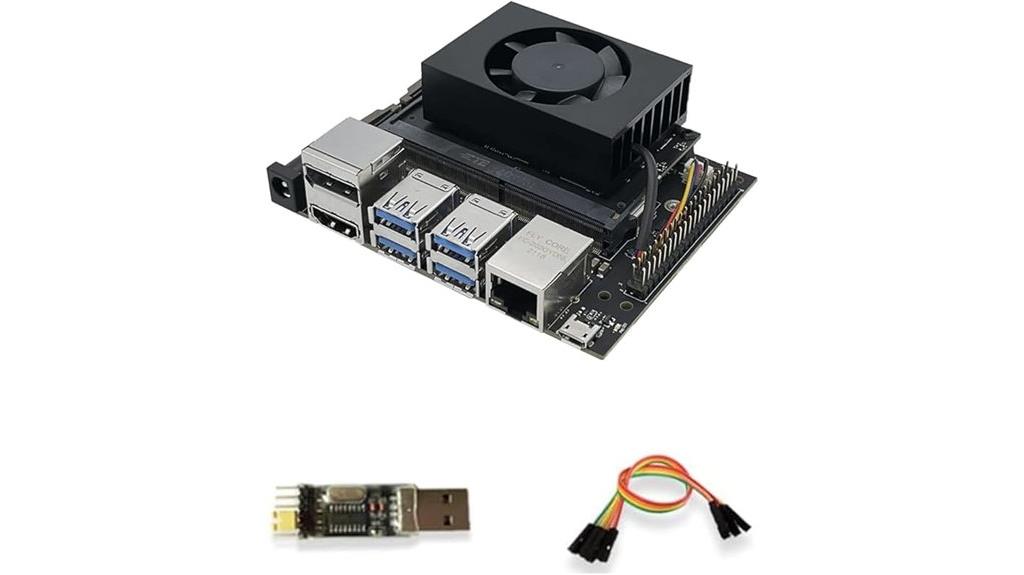
For aspiring AI developers seeking a reliable and high-performance platform, the Jetson Nano Kit with SD slot and 16GB eMMC offers an excellent choice. It’s based on NVIDIA’s Jetson Nano SOM with onboard 16GB eMMC, delivering faster data access and smoother processing for AI and machine learning tasks. The kit supports applications like image classification, object detection, and speech processing, making it versatile for prototyping and deployment. With fan cooling and compatibility with JetPack SDK, setup is straightforward. This kit combines robust hardware with software support, enabling me to develop, test, and run advanced AI models efficiently.
Best For: AI developers, researchers, and hobbyists seeking a reliable, high-performance platform for prototyping and deploying AI and machine learning applications.
Pros:
- Equipped with 16GB onboard eMMC for faster data access and improved performance.
- Supports a wide range of AI workloads including image classification, object detection, and speech processing.
- Compatible with JetPack SDK for easy setup and comprehensive software support.
Cons:
- Slightly more expensive than the standard 4GB Jetson Nano models.
- Requires adequate cooling solutions like fan cooling for optimal thermal management.
- May have a learning curve for beginners unfamiliar with NVIDIA Jetson ecosystems.
Factors to Consider When Choosing Jetson Nano Robotics Kits
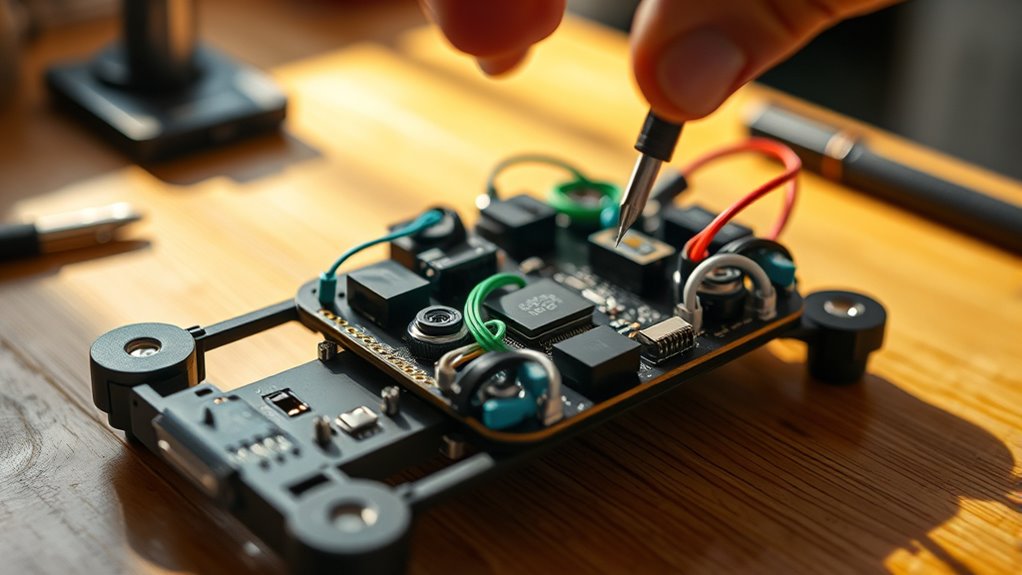
When choosing a Jetson Nano robotics kit, I focus on several key factors that guarantee I get the right fit. Compatibility with modules, power needs, and software support are essential for smooth operation, while build quality and expansion options affect durability and future upgrades. Considering these points helps me select a kit that’s reliable and adaptable for my projects.
Compatibility With Modules
Choosing a compatible Jetson Nano robotics kit begins with guaranteeing it matches your specific module version, whether that’s the 2GB, 4GB, or 16GB eMMC variant. Different kits support different modules, so double-check that your version is compatible. Next, confirm that the kit supports the necessary input/output interfaces like GPIO, CSI, MIPI, or USB ports, which are essential for connecting peripherals and sensors. The carrier board or mainboard should also match the form factor and connector standards of your Jetson Nano module to ensure a proper fit. Additionally, verify that the power supply options align with your module’s power requirements to avoid issues. Lastly, guarantee that the software and driver support are tailored for your specific module version for full functionality.
Power and Battery Needs
Selecting the right power and battery options is essential to guarantee your Jetson Nano robotics kit runs smoothly, especially for mobile projects. First, check the power supply requirements, including voltage and current, to ensure compatibility with your available sources. For batteries, consider whether a built-in rechargeable or external power pack suits your needs, especially regarding runtime. Evaluate the battery life and charging times to avoid frequent recharges during operation. Also, assess the robot’s power consumption to choose batteries that support your desired operational hours. Finally, consider the availability and cost of replacement batteries to maintain long-term usability and ease of maintenance. Proper power and battery planning ensures your project stays operational without interruptions, whether for prototyping or continuous use.
Software and Support
Ensuring that your Jetson Nano robotics kit has robust software support is essential for smooth development and long-term usability. I look for kits that support the latest frameworks like NVIDIA JetPack, ROS, or ROS2, ensuring compatibility with cutting-edge AI and robotics algorithms. It’s also critical to have comprehensive technical documentation, tutorials, and an active community to troubleshoot issues and learn new skills quickly. Regular firmware and software updates demonstrate that the manufacturer is committed to security, bug fixes, and performance improvements over time. Compatibility with popular development environments such as Python, C++, or JupyterLab provides flexibility in programming. Ultimately, clear upgrade paths and support for integrating additional sensors and peripherals are key to keep the kit adaptable as my projects evolve.
Build Quality and Durability
Build quality and durability play a vital role in the longevity and reliable performance of Jetson Nano robotics kits, especially when used in challenging environments. Choosing kits with robust materials like aluminum alloy or high-strength plastics helps protect internal components from impacts and harsh conditions. Precise assembly and secure connections reduce hardware failures and lower maintenance needs over time. Well-designed enclosures with effective thermal management, such as heatsinks and fans, keep components cool and prevent overheating. Additionally, durable mechanical structures built to high manufacturing standards ensure consistent functionality, even in outdoor or industrial settings. Prioritizing build quality means investing in a kit that withstands physical stresses and performs reliably, ultimately saving you time and resources while supporting your innovative projects.
Expansion and Connectivity
When choosing a Jetson Nano robotics kit, it’s essential to take into account its expansion and connectivity options, as these determine how easily you can add sensors, peripherals, and other hardware. Look for kits with a variety of I/O ports like USB, GPIO, CSI, and Ethernet to support diverse components. Compatibility with high-speed interfaces such as M.2, HDMI, and PCIe is fundamental for advanced expansion. Check if the kit offers pre-installed or easily upgradeable software support for integrating new hardware. Camera interfaces, like MIPI CSI-2, should support multiple or high-resolution cameras if your project demands it. Additionally, robust power management and cooling solutions are crucial to handle extra components without overheating or power issues, ensuring reliable operation as your system grows.
Intended Application Goals
Choosing the right Jetson Nano robotics kit depends heavily on your intended application goals, as this determines the hardware and software features you’ll need. First, identify if your project is educational, hobbyist, research, or industrial, which influences complexity and durability requirements. Consider the robot’s tasks—whether it’s object recognition, navigation, or manipulation—as these define hardware capabilities. If real-time processing or advanced AI models are necessary, you’ll need a kit with strong computational power and compatible frameworks. Also, think about the environment where the robot will operate—indoor, outdoor, or industrial settings—since durability and environmental resistance matter. Ultimately, verify the kit’s software ecosystem supports your sensors, cameras, and AI needs to meet your specific application goals effectively.
Budget and Cost Factors
Evaluating the budget and cost factors is crucial when selecting a Jetson Nano robotics kit, as it helps guarantee you choose a solution that fits your financial constraints without compromising essential features. Start by considering the total cost, including the base hardware, accessories, and any additional components like power supplies, SD cards, or cameras. It’s important to compare entry-level options with more advanced kits to see which offers the best value for your needs. Keep in mind that higher-priced kits often include better performance, extra features, or longer software support, which can be worthwhile investments. Balancing your budget constraints with the complexity and capabilities of the kit ensures you get a suitable solution without overspending, setting a strong foundation for your project’s success.
Frequently Asked Questions
What Compatibility Issues Might Arise With Different Robotics Kits?
When considering different robotics kits, I always worry about compatibility issues. Sometimes, the kits use different hardware interfaces or software platforms, which can cause conflicts or require extra adapters. I make sure to check if the kit supports the Jetson Nano’s GPIO pins, power requirements, and software libraries. Compatibility is key to ensuring smooth assembly, programming, and future upgrades without running into frustrating setbacks.
How Do Power Requirements Vary Among These Jetson Nano Kits?
When I look at power requirements, I see they vary based on the kit’s complexity, sensors, and peripherals. Some kits need a stable 5V power supply, while others require higher wattage or dedicated power sources. I recommend checking each kit’s specifications carefully, ensuring your power setup matches their needs. This way, I can avoid issues like underpowering or damage, keeping my projects running smoothly and efficiently.
Are There Specific Programming Languages Supported Across All Kits?
You’re wondering if all Jetson Nano kits support the same programming languages. I’ve found that most kits primarily support Python, which is ideal for robotics and AI projects. Some kits also support C++, especially for performance-critical tasks. Overall, the software environment is quite consistent, allowing you to develop and run your code seamlessly across different kits. This makes it easier for aspiring innovators like you to get started without compatibility worries.
What Is the Learning Curve for Beginners Using These Kits?
The learning curve for beginners varies, but I find that most kits are designed to be accessible. They often include detailed tutorials and user-friendly interfaces, making it easier to get started. I recommend starting with kits that have strong community support and clear documentation. With patience and practice, I believe anyone can quickly grasp the basics and begin creating exciting projects.
Which Kits Offer the Best Expansion Options for Future Upgrades?
Ever wondered which kits let you grow your project over time? I’ve found that kits with modular components, like the NVIDIA Jetson Nano Developer Kit paired with compatible sensors and expansion boards, offer the most flexibility. They let you add cameras, sensors, or even AI modules easily. This way, your robot can evolve with your skills, making it perfect for future upgrades and more complex projects.
Conclusion
Choosing the right Jetson Nano robotics kit is like picking the perfect paintbrush for your masterpiece—each one open a new world of innovation. Whether you’re a teen or an aspiring engineer, these kits are your launchpad to endless creativity. So, gear up and plunge into—your future robotic marvels are just a kit away, ready to take flight and transform your ideas into reality. Let’s turn imagination into action!



